The Effects of Subtle External Stimuli on Chiral Symmetry Breaking During Crystallization of Sodium Chlorate from Aqueous Solutions
B. Rubik1
Institute for Frontier Science, 6114 LaSalle Ave PMB 605, Oakland, CA 94611, USA
*Correspondence: brubik@earthlink.net
Keywords: magnetic field, acoustic field, water structurizer, structured water, activated water, subtle field, subtle energy, torsion field, crystallization, chirality
Published: June 13, 2021
Abstract
How does chiral symmetry breaking occur such that biomolecules have a distinct handedness that is essential for life? The purpose of this study is to test whether certain subtle external stimuli influence chiral symmetry breaking using a model system of sodium chlorate crystallization from aqueous solutions. In 28 controlled experiments, aliquots of a stock solution of sodium chlorate (NaClO3) were transferred to crystallization dishes and incubated 24-30 hours. Crystals formed slowly by evaporation under isothermal conditions. Controls were left untreated while test solutions were exposed to the following subtle external stimuli: (1) a dynamic magnetic field; (2) 432 Hz sine wave acoustic field; (3) Amezcua BioDisc-3, a purported water structurizer; (4) Purple Plate, a subtle energy product; and a (5) wooden pyramidal structure. In addition, several experiments were performed with solutions using Vivo® structured water, a commercial product. The number and chirality of crystals from all experiments were analyzed using polarimetry to distinguish d-crystals from l-crystals. Data was pooled for each exposure condition. While controls yielded no significant difference in the percentage of d-crystals and l-crystals, a significantly larger percentage of d-crystals were found for test conditions (2) 67% (p=0.049); (3) 81% (p=0.034); and (4) 64.9% (p=0.003). Test conditions (1), (5), and Vivo® aqueous solutions produced insignificant differences. This study demonstrates that aqueous solutions are open systems that may be impacted by certain subtle external stimuli that influence solute crystallization and chiral asymmetry.
Introduction
Chirality is the ability of an object to exist in two opposite configurations that are mirror images of one another, such as right and left hands. Molecules or crystal lattices presenting two such configurations are chiral. Chirality and chiral asymmetry are observed throughout the natural world. Besides the quantum spin of particles and chiral biomolecules, there are spiral seashells, spirally climbing vines, and spiral galaxies, among other forms. The origin of homochirality is one of the great unanswered questions in physics, chemistry, the origin of life, and evolutionary science. Therefore, studies on the processes and mechanisms of action that lead to chiral symmetry breaking are of general interest.
There is an overwhelming single-handedness of the components of life. Biomolecules are chiral and enantiomerically pure, with L-amino acids and D-sugars as building blocks of larger biomolecules. Enantiomers have the same physical properties such as melting point and refractive index, but typically have quite different biological properties since the absolute configuration of biomolecules with stereo-specificity determines biologic effect.
Chiral symmetry breaking may be related to prebiotic mechanisms and the origin of life. Is it chance or determinism? Although numerous laboratory experiments have produced some degree of homochirality, the mechanism of chiral symmetry breaking in aqueous solution is poorly understood. Various model systems have been used to probe this question.
Long ago it was discovered that sodium chlorate (NaClO3) is an achiral compound that exhibits chirality only in its crystal forms (Kipping and Pope, 1898). It forms two types of crystals with chiral enantiomeric crystal lattices. Enantiomers are “optically active” in that they react differently to polarized light. One enantiomeric crystal rotates the plane of polarized light to the right (clockwise), is dextrarotatory, and is known as the d-form, whereas the other rotates the plane of polarized light to the left (counter-clockwise) is levorotatory, and is known as the l-form. Since aqueous solutions of sodium chlorate are achiral, it has been an important model system for studying chiral symmetry breaking during crystallization (Pagni and Compton, 2002).
Sodium chlorate crystals grown from aqueous solution are isotropic, well-formed, colorless crystals of symmetry group P213, which allows for measurement of optical activity using polarimetry. On the average a 50:50 mixture of d-crystals and l-crystals are obtained. Various perturbations of sodium chlorate solutions have been shown to yield a greater amount of one enantiomeric crystal. Crystallization from water containing D-mannitol yields mostly d-sodium chlorate crystals (Pagni and Compton. 2002). Solutions exposed to beta particles, which are spin-polarized, from radioactive 38Sr90, yielded predominantly d-crystals (Mahurin et al., 2001). NaClO3 crystallizations exposed to positrons, which are spin-polarized in a direction opposite that of beta particles, from radioactive 11Na22, produced mostly l-crystals (Mahurin et al., 2001).
Is there an effect of various subtle external stimuli, some of which purportedly affect water structure, on chiral symmetry breaking during sodium chlorate crystallization? Five different stimuli (treatments) were applied in controlled experiments: (1) dynamic magnetic field produced by LightStream Harmonics (Web Ref. 1); (2) continuous 432 Hz sine wave acoustical field; (3) Amezcua BioDisc-3 (Web Ref. 2), a disk placed under the samples; (4) Purple Plate (Web Ref. 3), an aluminum plate placed under the samples; and (5) open wooden pyramidal structure placed over the samples. In addition, we utilized Vivo® microstructured water (Web Ref. 4; Wang et al., 2004) compared to heated Vivo® water (unstructured) in some experiments. It was hypothesized that structuring of the aqueous solution resulting from one or more of these treatments would have an influence that might lead to chiral symmetry breaking and an excess of one chiral crystal form.
Methods
Aqueous Solution Preparations
Preparation of stock solution for each experiment was as follows. Reagent grade crystalline sodium chlorate was dissolved in water to make an 8M solution (8.52 g/100 ml), a nearly saturated solution at 25oC. Type 1 laboratory water (ultrapure; 18.2 megaohms-cm) produced from a Barnstead Diamond/B-pure water purification system was used throughout the study to prepare the solutions except for experiments in which Vivo® structured water (Lorenzen, 2000; Wang et al., 2004) was used. The stock solution was boiled for 3 minutes to dissolve any crystals and then allowed to sit and cool at room temperature for 15 minutes. Aliquots (10 ml) of the stock solution were transferred by pipette into each of 12 identical Pyrex® crystallization dishes, 7 cm diameter x 4 cm deep. This created an 8 mm layer of solution in each open dish in which crystals grew by slow evaporation under ambient temperature. Six test dishes that received a single treatment were placed approximately 5 meters apart from the 6 control dishes that were untreated. The two locations were selected such that ambient light and electrosmog levels were identical, and controls and test samples were randomly assigned to these locations for each experiment. The 12 samples were incubated unperturbed for 24-30 hours until macroscopic crystals at least 3 mm in size had formed in each dish. Although the same crystallization dishes were used for each experiment, they were washed, rinsed with ultrapure water, and dried before reuse. All experiments were conducted between July-October, 2019.
External Stimuli (Treatments) Applied During the Crystallization Process
Each experiment consisted of a test group that was exposed to a single test condition compared to untreated controls. Five types of external treatments were used in 28 experiments: (1) dynamic magnetic field produced by LightStream Technology (Web Ref. 1); (2) 432 Hz continuous sine wave acoustic field; (3) BioDisc-3 (Web Ref. 2), a device previously shown in controlled studies to structure water and have beneficial clinical effects (Korotkov, 2019; Korotkov et al., 2019); (4) Purple Plate (Web Ref. 3), a purported subtle energy device; and (5) pyramidal open wooden structure. In addition, Vivo® water (Wang et al., 2004) was used in one set of experiments. Vivo® water (Web Ref. 2) is a patented, stable, commercially available, microstructured water (Lorenzen, 2000) activated by means of a strong magnetic field and exposure to light. For the control condition, Vivo® water was boiled three minutes to destroy all nanostructuring (Lorenzen, 2019), and in the test condition, neither the water nor the aqueous solutions were boiled.
1. Dynamic magnetic field. The dynamic magnetic field utilized the LightstreamTM Harmonics activation system (Web Ref. 1) with its Water Restructuring audiofile program that was converted and amplified to 2Vrms to power the 12” diameter 7-level copper Star Coil transmitter shown in Figure 1. The crystallization dishes were placed on a 5 mm thick PlexiglasTM plate on top of the coil as shown and treated for 24-30 hours during crystallization.
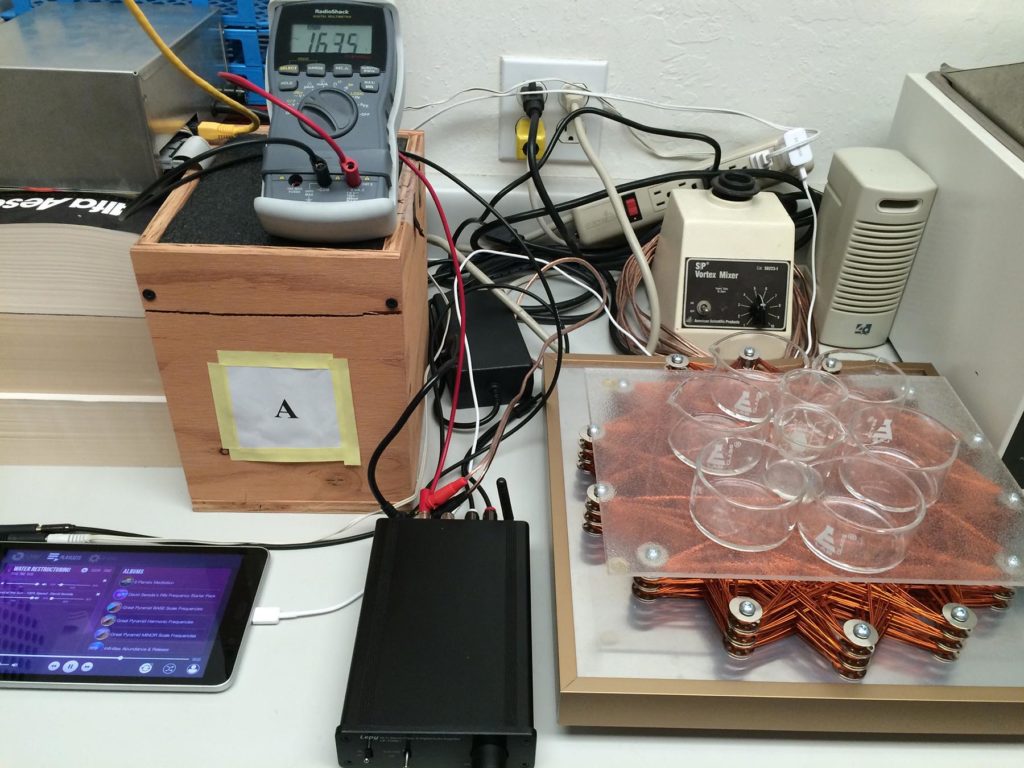
Figure 1. Setup for dynamic magnetic field stimulation of the crystallization process using LightStreamTM coil with its Water Restructuring program converted and amplified to power the coil.
2. 432 Hz sine wave acoustical field. The 432 Hz sine wave acoustic stimulus was produced using a computer that played an audiofile from NCH Tone Generator software that was attached to 2 Altec Lansing speakers ACS295 (without woofer) driven at 3Vrms. The test dishes were grouped together and the speakers, placed to the right and left, were within 5 cm to 20 cm. In the past, 432 Hz was the traditional reference frequency used to tune musical instruments. A continuous acoustic field of 432 Hz sine waves was applied to the test samples for 24-30 hours during crystallization. The volume of the auditory signal was barely audible.
3. BioDisc-3. The Amezcua BioDisc-3 (Web Ref. 2) is a clear glass-like disk composed of granulated crystals, including quartz and diamond, activated by means of a proprietary energetic process. In previous studies, this commercial product has been tested in controlled studies where it was shown to alter certain physical properties of water as well as boost seed germination and plant growth (Korotkov, 2019). Moreover, in a controlled clinical study, consumption for 30 days of one liter/day of water treated by Bio-Disc-3 was shown to produce numerous beneficial health effects (Korotkov et al., 2019). The disk is 9 cm in diameter and 1 cm thick and has several geometric relief designs on the top and bottom that are considered energetically active (See Figure 2). In the test condition, each sample dish was placed on top of a BioDisc-3 for 24-30 hours during crystallization.

Figure 2. Amezcua BioDisc-3 showing the geometrical relief patterns of dots, parallel lines, concentric circles, and other patterns.
4. Purple Plate (Web Ref. 3). These plates are made from purple anodized aluminum that have been activated by a proprietary process involving electromagnetic frequencies, acoustics, and human intention, which is said to force it into a more homogeneous structure. This technology is purportedly inspired by Nikola Tesla and was developed in the 1970s by Ralph Bergstresser, who claimed to have been an associate of Tesla. The device is said to “energize” water, among other effects, and can produce changes in the taste of food and drink (Web Ref. 3). No published studies on this product were found. A 12 x 12-inch Purple Plate was placed under the test crystallization dishes. See Figure 3.
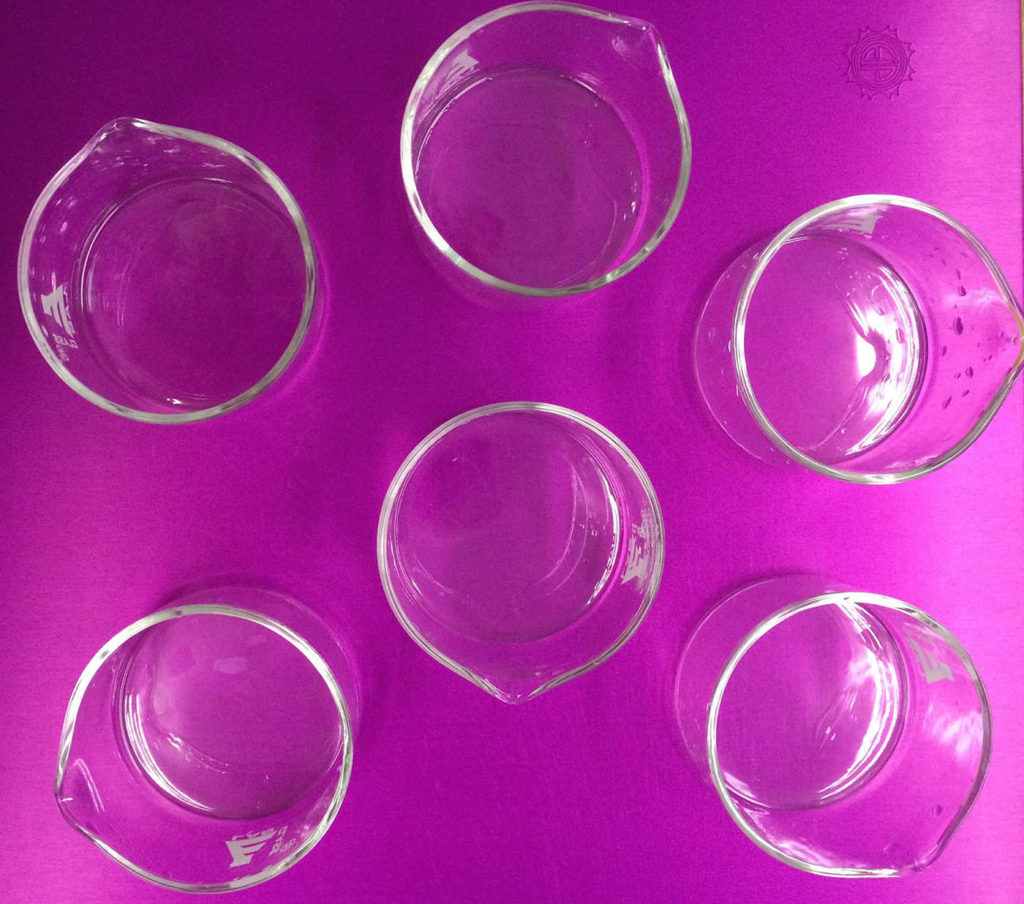
Figure 3. Purple Plate treatment of test samples during crystallization.
5. Pyramidal Structure. A 0.5m open wooden pyramidal structure of equilateral triangular geometry, oriented with sides parallel to geomagnetic north, was placed over the test samples as shown in Figure 4. A previous study with this pyramidal structure yielded 19% more biomass when bean seeds were germinated and grown in trays under the pyramid for one month compared to controls (Rubik and Jabs, 2016).
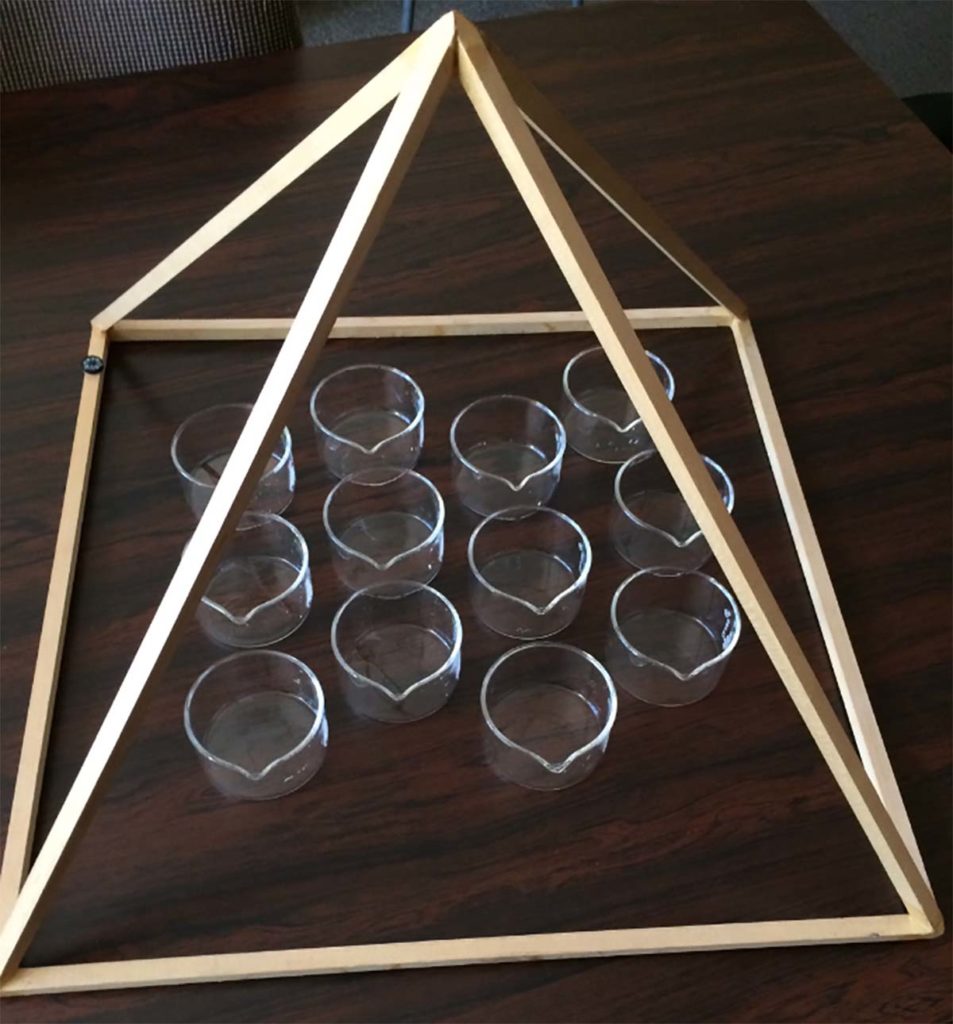
Figure 4. Pyramidal structure oriented to geomagnetic north placed over test samples.
6. Vivo® Structured Water. Experiments using Vivo® structured water (Web Ref. 4; Wang et al., 2004) were conducted to see whether structured water used to prepare the solutions might contribute to chiral symmetry breaking. Although this structured water is stable at room temperature, boiling the water destroyed any structuring (Lorenzen, 2019). We compared crystallization using unheated Vivo® water in test samples with boiled Vivo® structured water in the controls.
Polarimetric Analysis
Polarimetric methods can readily distinguish d-crystals from l-crystals and determine the numbers and percentages of each of them (Bradshaw et al., 2015). Two crossed linear-polarizing filters were used to assess, by the naked eye, whether rotation of the plane of polarized light was clockwise (d-crystals) or counterclockwise (l-crystals) for each crystal. A commercial polarimeter was not required. The light used was incoherent, produced by an ordinary fluorescent tube lamp. Each sample crystallization dish was analyzed for the number of crystals that displayed the two types of optical activity. Crystal size was disregarded as long as some 3 mm crystals had formed. The naked eye can only perceive optical activity in crystals at least 1 mm in size. Since this was an initial experiment to look for effects, crystal size and size distribution of crystals were not measured. The masses of d-crystals and l-crystals were not measured.
Data from all experiments for each treatment type were pooled and then analyzed. The percentages of l-crystals and d-crystals were calculated. Paired t-tests were used to analyze for statistical significance between controls and test samples. The enantiomeric excess was calculated. We define enantiomeric excess as:
ee (%) = [nd – nl]/[nd + nl] x 100%. (1)
For equal numbers of d-crystals and l-crystals, ee = 0%. A positive ee refers to excess d-crystal forms over l-crystal forms, and vice versa.
Paired t-tests were calculated to compare the number of l-crystals and d-crystals for the pooled data from control and test conditions to test for statistical significance of observed chiral differences.
Results
Figure 5 shows a typical photograph of the crystals for one set of dishes. Each sample yielded a variable number of crystals at the endpoint when measurements were made.
Figure 6 shows a typical photograph of the crystals between polarizers, with the analyzer rotated to the right and left, respectively, showing how d– and l-crystals appear light or dark.
Table 1 shows the pooled raw data and data analysis for all experiments.
Control crystals were analyzed and showed 49.4% l-crystals and 50.6 d-crystals, a random distribution that was insignificant (p=0.435). No significant differences were found for Vivo® water (p=0.240), the dynamic magnetic field (p=0.200), and the pyramid (p=0.312). Statistically significant differences in the numbers of l– and d-crystals were obtained for 3 conditions: 432 Hz audio signal (p=0.049), BioDisc-3 (p=0.034), and Purple Plate (p=0.003). In each of these test conditions that led to significant differences, d-crystals predominated.
Figure 7 depicts graphically the percentages of l-crystals and d-crystals for all experimental conditions.
In addition, there were some noteworthy qualitative changes in the treated samples. It was found that a smaller number of crystals formed in the BioDisc-3 treated samples, which were also larger and more perfectly formed with greater transparency. In several cases crystals that were hexagonal in morphology were observed.
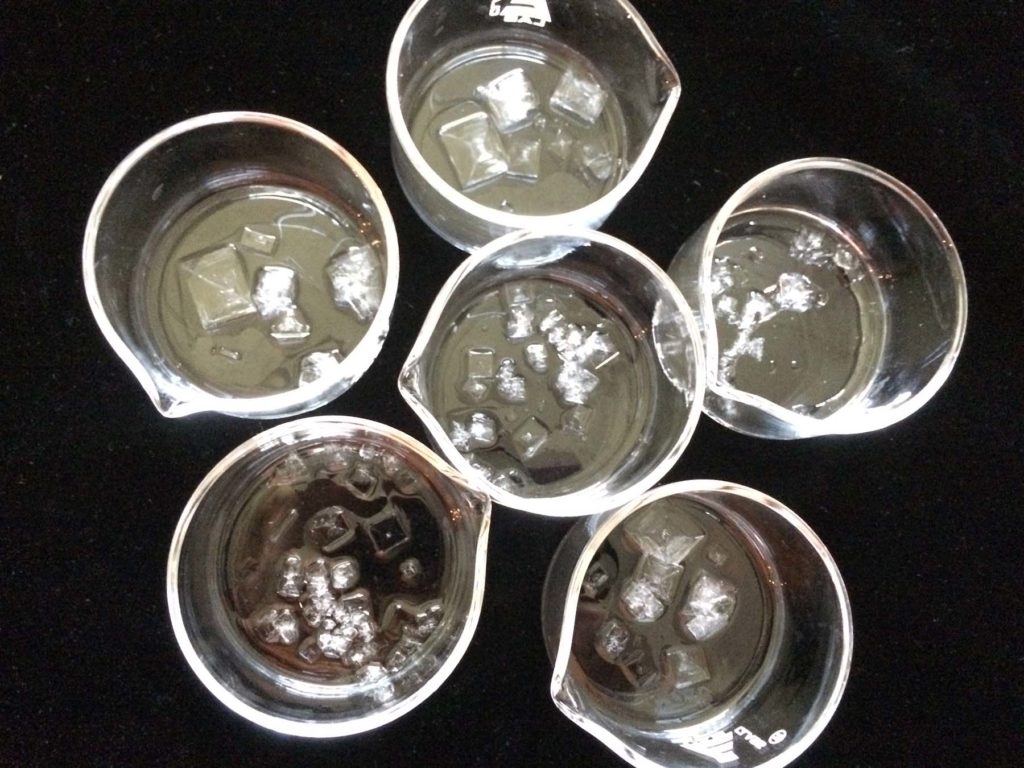
Figure 5. Typical results of sodium chlorate crystallization in six samples viewed under ordinary light.
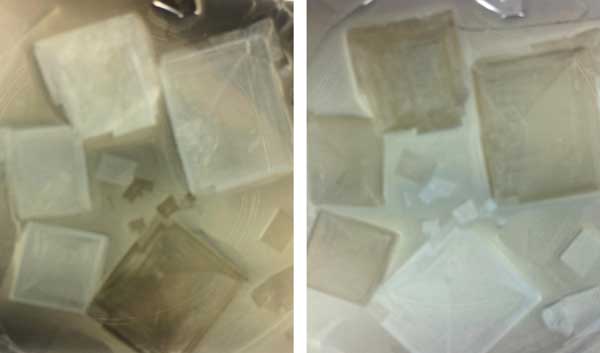
Figure 6. Sodium chlorate crystals viewed under polarized light with rotation of the analyzer in opposite directions to show the two chiral forms; (a), analyzer rotated to the right; (b) analyzer rotated to the left.
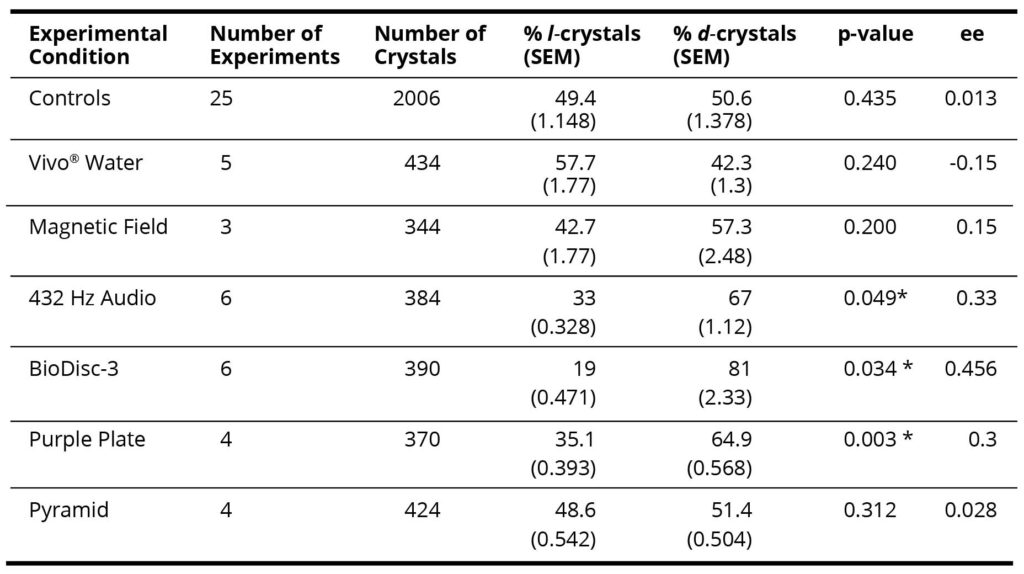
Table 1. Summary of all data for all control and test conditions. % l-crystals and d-crystals with standard error of the mean (SEM); p-values from t-tests; and ee values. Statistically significant differences (p<0.05) are marked with asterisks (*).
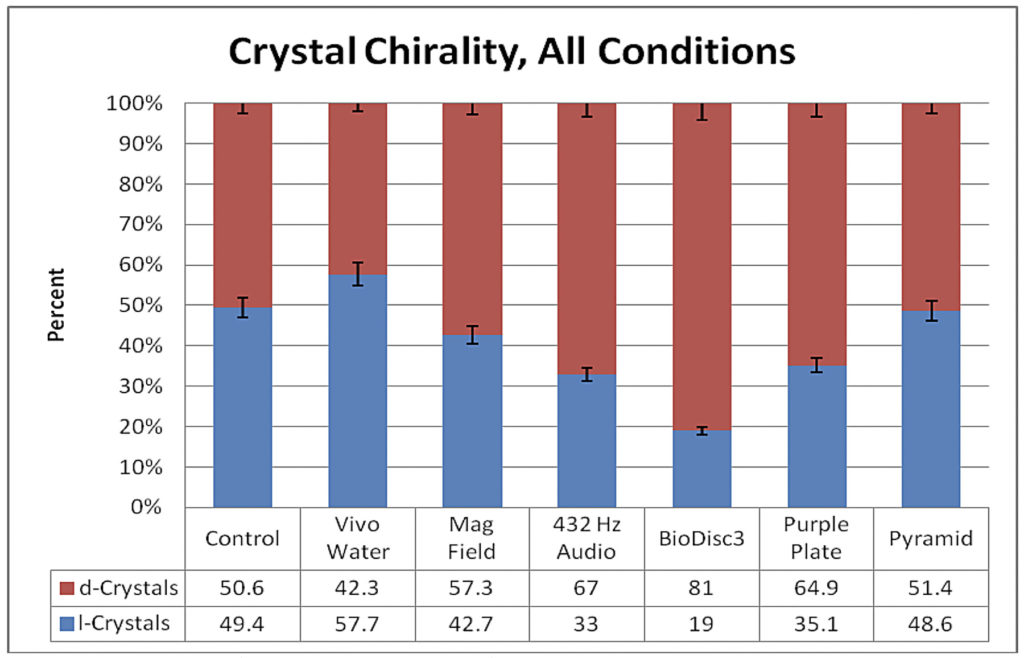
Figure 7. Percentage of l-crystals and d-crystals for all conditions. Error bars indicate standard error of the means (SEM).
Discussion
Presently there is no accepted model for describing and predicting processes occurring in water or aqueous solutions under the influence of a wide range of physical factors, such as acoustic, magnetic, or subtle energy fields. Therefore, discussion of these results is necessarily qualitative and speculative.
Vivo® water, a commercial bottled product that is purportedly a stable structured water, has been shown to have altered NMR (nuclear magnetic resonance) spectra compared to other waters and beneficial health effects on diabetic patients in clinical trials. It loses its structure upon heating. Since we boiled the water in the test condition, the Vivo® water structure was undoubtedly eliminated (Lorenzen, 2019). Moreover, the high ionic strength of 8M sodium chlorate in both test and control conditions would be expected to alter the water structure. The test condition showed 57.7% l-crystals and 42.3% d-crystals, although this difference was insignificant (p=0.24). The absence of an effect on chiral symmetry breaking for experiments using Vivo® water served as an additional control since water that was structured previously cannot retain its structure upon boiling or in 8M salt solution.
Experimental findings that BioDisc-3 may alter the structure of water cannot fully explain chiral symmetry breaking in this study. This is consistent with earlier research demonstrating that certain external treatments, beta and positron radiation, lead to chiral symmetry breaking for this crystal system (Mahurin et al., 2001). In addition, a direct current electric field stimulation (3.5 – 17.5 V/cm) of the aqueous solution was also shown to yield more d-crystals (Chen and Chen, 2006). Such treatments may act on the aqueous solution and crystallization process by different mechanisms.
Regarding the present study, what might be the mechanism of action of these treatments on the crystallization process? BioDisc-3 is a clear glass-like disk that is comprised of a proprietary blend of crystals, including quartz and diamond, activated by means of a proprietary energetic process, which has been shown in previous studies to alter the physical and biological properties of water (Korotkov, 2019) and generates beneficial clinical effects from treated water (Korotkov et al., 2019). In these previous studies, there was no direct contact between the disk and the water. In a similar study on a completely different system, crystalline minerals of a proprietary mixture placed adjacent to a container of water have been shown to alter the water’s structure. Swanson (2010a) reported that water in a sealed glass (or plastic) bottle placed within a larger container filled with Anchi mineral crystals for three days showed significant changes in the Raman spectra, indicating a 25% increase in O-H stretch band, which was significant. Moreover, this spectral change slowly reverted after the crystals were removed (Swanson, 2010a). Another study by different investigators reported that a cell-like ice structure for liquid water formed when treated with a hydrophilic ceramic power in a non-contact manner (Hwang et al., 2018). Such studies suggest the possibility that a “subtle energy field” associated with the crystalline minerals passes through the solid container to change the water structure.
Experimental studies by various researchers over numerous decades demonstrate experimental results that point to a “subtle energy” that is frequently associated with life (Rubik, 1995; 1997). Needless to say, this concept goes beyond conventional science. Human subjects have been shown to change the physical properties of water by intention to energize the water, as seen in altered corona discharge patterns of water droplets measured with high voltage electrophotography (Rubik, 2011). Ultraviolet spectroscopic properties of distilled water were altered by charging it with a subtle energy (“orgone energy”) inside a Reich Orgone Accumulator (DeMeo, 2018). Remnants of a subtle field of biological origin in coral calcium was found to influence water differently from controls as shown in the droplet evaporation method (Jerman, 2021). Water that has been charged with “subtle energy,” resulting in a detectable change in physical (and/or biological) properties is often referred to as “activated” or “structured” water (Smirnov, 2000; 2005).
Experimental findings that BioDisc-3 may, however, alter the structure of water in ways that cannot be fully explained by chiral symmetry breaking. Moreover, BioDisc-3 showed no optical activity when it was placed between the polarizer and analyzer using polarimetry. How might such treatments lead to chiral asymmetry? Is there a crypto-chiral aspect involved, or a violation of parity?
One possible explanation for chiral symmetry breaking may be torsion fields that exhibit extremely weak chiral forces. Nikolai Kozyrev, a Russian astrophysicist, proposed a fifth force, the torsion field, although his hypothesis was never accepted by conventional physics. In brief, his theory states that an irreversible process leads to a local change in entropy, and that this change causes a local change in the density of time, which is then conveyed in a twisting wave through space carrying a torsion energy field (Kozyrev, 1958). Wilhelm Reich had also proposed that orgone energy exhibited kreiselwelle (spiral waves) in both the microscopic and macroscopic realms (DeMeo, 2019). Applications of torsion energy such as “torsion field generators” have been invented and patented. Right-handed torsion is purportedly emitted from processes that increase entropy, such as the melting of ice; whereas left-handed torsion is purportedly emitted from processes that decrease entropy, such as crystallization.
One consequence of this is that torsion field energy of a particular handedness can be stored in an object and transmitted from one object to another object nearby. Thus, BioDisc-3, an invention involving a unique combination of materials including quartz crystals, which are chiral l-forms or d-forms, and involving proprietary energetic activation, may have been engineered to store torsion field energy. This energy is possibly transferred to the aqueous solutions in this study. As a crystal nucleus forms in the saturated aqueous solution, the chiral pattern is thereby determined by the torsion field chirality, and crystal growth simply replicates it. Therefore, the chirality of the torsion field transmitted by BioDisc-3 might be the asymmetric force leading to chiral symmetry breaking during crystal nuclei formation. Since left-handed torsion is associated with vitality, coherence, and greater organization, and BioDisc-3 has been shown in controlled studies to have numerous beneficial effects on living systems, it is hypothesized that a left-handed torsion field is transmitted by BioDisc-3. Sodium chlorate d-crystals absorb left-handed torsion and would therefore be expected to predominate. Furthermore, BioDisc-3 as a purported water structurizer, which in 2 independent studies (Korotkov, 2019; Korotkov et al., 2019) produced significant effects on seed sprouting, human physiology, and changes seen in high-voltage electrophotography, might also be expected to have long-range ordering effects on the aqueous solutions that may further amplify any chiral ordering effect. Such long-range ordering effects of the aqueous solution might contribute to the results obtained as the structuring of the solution might convey information about the particular chirality achieved in one region of the sample to another region, thus leading to a greater proportion of d-crystals. This may explain why BioDisc-3 achieved the highest level of chiral symmetry breaking of all stimuli, with 81% d-crystals and 19% l-crystals, and an ee value of 0.456.
The observation of hexagonal crystals forming from BioDisc-3 treatment is unprecedented, since NaClO3 is of the cubic symmetry class. However, since BioDisc-3 acts as a purported water structurizer, and ice crystals are hexagonal, this change in the crystal habit of sodium chlorate may be related to BioDisc-3’s influence on the aqueous solution.
Vibration is known to affect crystallization as a mechanical stimulus promoting nucleation. Although sound has been shown to improve the crystallization of proteins (Zhang et al., 2016), no scientific literature on sonic effects on the crystallization of inorganic compounds was found. Previous experiments on pure water droplets stimulated by acoustic 432 Hz using the Gas Discharge Visualization Camera (high voltage electrophotography) showed a significant increase in the size of the corona discharge (Rubik, unpublished data), which suggests a possible change in water structure (Korotkov and Orlov, 2010) from this stimulus. Since every process has associated torsion fields, we speculate that the chiral symmetry breaking from 432 Hz stimulation may also relate to ordering effects from a predominance of left-handed torsion in this stimulus. However, acoustic vibration of the solutions may produce hydrodynamic shear that can propagate secondary nucleations of the same chirality, thereby amplifying the symmetry breaking. Thus, the mechanism of action of 432 Hz on the crystallization process may be more complex than torsion fields alone.
Another possible explanation underlying the chiral symmetry breaks observed here refers to the existence of a real cosmic background radiation of a new form of matter based on energy from an underlying vacuum ground state (Volkamer, 2003). This discovery has ramifications for gravitation as well as for certain chemical reactions and may also cause special effects in the structure of ordinary matter (Volkamer and Streicher, 1999).
There are important applications of chiral symmetry breaking in the pharmaceutical industry. Many drugs have chiral forms. One form of enantiomer is generally preferred as a viable drug for its beneficial health effects, while the other enantiomer may be inactive or even toxic. Crystallization-based methods are used to resolve enantiometers when asymmetric synthesis or chiral chromatography are not feasible. Based on results seen in this study, purported water structurizers such as BioDisc-3 may prove to be useful in enantiomer resolution via preferential crystallization of the desired pure enantiomer. It would be worthwhile to explore this in future studies.
Although statistical significance was obtained for some results, one limitation of this study is the small number of experiments and numbers of crystals analyzed. Further research with greater numbers of experiments and crystals would be important to replicate these findings and extend them. There is a small possibility that chiral contaminants from the atmosphere directed the chiral symmetry breaking and confounded the study. However, this would be expected to appear in both test conditions and controls, and since it did not, it may be discounted.
It would be worthwhile to explore the effects of other external stimuli, including other purported subtle energies, on chiral symmetry breaking. It would also be worthwhile to observe and record both local and sidereal times of experiments, to investigate whether there may be geophysical and/or astronomical influences on chiral symmetry breaking in light of Kozyrev’s torsion field theory.
Conclusions
Chiral symmetry breaking is a poorly understood phenomenon that is still under scientific investigation. This study contributes to a greater understanding of chiral symmetry breaking in aqueous solution and also leads to further questions. Aqueous solutions, like water, are complex, open, nonequilibrium systems, characterized by subtle structural and informational states in relation to the environment. A growing body of scientific literature shows that water can receive information encoded in energy fields and transmit it. In this study, certain devices that are purported external “water structurizers” produced a statistically significant effect on chiral symmetry breaking in the crystallization of sodium chlorate from aqueous solution, achieving a greater percentage of d-crystals over l-crystals that showed statistical significance. We speculate that such subtle external stimuli may involve torsion fields as subtle chiral forces that break chiral symmetry, impacting the nucleation stage of crystallization of sodium chlorate in aqueous solution. This study may inspire further investigation of mechanisms of action of subtle external stimuli on water and aqueous solutions, crystallization of solutes from aqueous solution, and chiral symmetry breaking.
References
Bradshaw D S, Leeder J M, Coles M M, Andrews D L (2015). Signatures of material and optical chirality: origins and measures. Chem. Phys. Lett. 626: 106–110.
Chen W C, Chen X L (2006). Chiral symmetry breaking during growing process of NaClO3 crystal under direct-current electric field. Chin. Phys. Lett. 24(1): 252-255.
DeMeo J (2018) Anomalous “living” spectrographic changes in water structures: explorations in new territory. Water: A Multidisciplinary Research Journal DOI: 10.14294/WATER.2018.6
DeMeo J (2019) The Dynamic Ether of Cosmic Space. Natural Energy Works, Ashland, Oregon, p. 245.
Hwang SG, Hong JK, Sharma A, Pollack GH, Bahng, GW. (2018) Exclusion zone and heterogeneous water structure at ambient temperature. PLOS ONE 13(4)
Jerman I (2021). Detecting subtle field effect from coral calcium via droplet evaporation method. Water: A Multidisciplinary Research Journal 12: 1-16.
Kipping F S, Pope W J (1898). LXIII—Enantiomorphism. J. Chem. Soc. Trans. 73: 606–617.
Korotkov K, Orlov D. (2010) Analysis of electrophotonic glow of liquids. Water 2: 29-43.
Korotkov K. (2019). Study of structured water and its biological effects. International Journal of Complementary and Alternative Medicine 12(5): 168-172.
Korotkov KG, Churganov OA, Gavrilova EA, Belodedova MA, Korotkova AK (2019). Influence of drinking structured water to human psychophysiology. J Applied Biotechnol Bioeng 6(4): 171-177.
Kozyrev N A (1958). Causal or Unsymmetrical Mechanisms in Linear Approximation. Pulkovo Observatory. (In Russian) Translated chapter: Anon. (2010) Possibility of experimental study of the properties of time. Abraham Zelmanov Journal 5: 188-220.
Lorenzen L H (2000). Microclustered Water. US Patent 6,033,678. March 7, 2000, 1-8.
Lorenzen, LH (2019) personal communication: boiling destroys the structure of Vivo® water.
Mahurin S, McGinnis M, Bogard J S, Hulett L D, Pagni R M (2001). Effect of beta radiation on the crystallization of sodium chlorate from water: a new type of asymmetric synthesis. Chirality 13: 636–640.
Pagni R M, Compton R N (2002). Asymmetric synthesis of optically active sodium chlorate and bromated crystals. Crystal Growth & Design 4: 249-253.
Rubik B. (1995) Energy Medicine and the Unifying Concept of Information. Alternative Therapies in Health and Medicine, March, vol. 1(1): 34-39. PMID: 9419791.
Rubik B. (1997) The unifying concept of information in acupuncture and other energy medicine modalities. Proceedings of the 1996 Medical Acupuncture Research Foundation Symposium on the Physiology of Acupuncture. Journal of Alternative and Complementary Medicine, 3 (Suppl. 1): S-67 – S-76.
Rubik B. (2011) The power of “magnetized” water. (Chapter 18) In: Bragdon, E. (editor) Spiritism and Mental Health. Jessica Kingsley Publishers, Philadelphia, PA, pp. 201-211.
Rubik B, Jabs H (2016). Interaction of pyramidal structures with energy and consciousness. Cosmos and History: Journal of Natural and Social Philosophy 12(2): 259-275.
Smirnov I (2000). Method and device for producing activated liquids and methods of use thereof. US Patent 6,022,479. Feb 8, 2000, 1-10.
Smirnov I V (2005). Introduction to the Biophysics of Activated Water. Universal Publishers, Boca Raton, FL. pp 1-24.
Swanson C (2010a). Life Force, The Scientific Basis. Poseidia Press, Tucson, AZ. pp.234-235.
Volkamer K (2003). Detection of dark-matter-radiation of stars during visible sun eclipses, Nuc. Phys. B (Proc. Suppl.) 124: 117-127.
Volkamer K, Streicher C (1999) Experimental evidence of a new type of quantized matter with quanta as integer multiples of the planck mass. Apeiron 6: 63-82.
Wang Z Y, Zhou Z C, Zhu K N, Wang X, Pan J G, Lorenzen L H, Zhou M C (2004). Microclustered water and hydration. Asia Pacific Journal of Clinical Nutrition, 2004 Supplement 13: S128.
Zhang C Y, Wang Y, Schubert B, Liu Y, Wang M Y, Chen D, Guo Y Z, Dong C, Lu H M, Liu Y M, Wu Z Q, Betzel C, and Yin D C (2016). Effect of audible sound on protein crystallization. Crystal Growth & Design 16 (2): 705-713.
Web References
1. http://davidsereda.co/ [02-09-2021]
2. https://www.qnet.net/bio-disc-3/ [02-09-2021]
3. https://purpleplates.com [02-09-2021]
4. https://www.4vivo.com/category-s/2.htm [02-09-2021]
Discussion with Reviewers
Reviewer 1: You found that a smaller number of crystals formed in the BioDisc-3 treated samples, which were also larger and more perfectly formed with greater transparency. This description indicates that there is some effect on the size of the crystals in addition to the number of crystals. How much larger were these than the average size of the crystals? By 10%? 50%? BioDisc3 shows much larger number of d-crystals that were also larger in size?
Author: The effect on crystal size that I noted with BioDisc-3 treatments was unexpected and not part of my research question for this study. In response to another of your questions, I did not measure crystal size or size distribution. Please consider this as “anecdotal evidence” that I simply reported in the manuscript that would require further experimentation.
Reviewer 1: One of the well-known water structures, described as the exclusion zone, was found to form on the surface of hydrophilic materials. This result indicates that the electric field at the hydrophilic surface plays an important role in water structure formation. Can you add any discussion about this exclusion zone water structure and the water structure formed by external stimulation of the subtle field?
Author: Since my study probably does not involve exclusion zone water per se, I prefer to not modify my paper to discuss this but will discuss it here instead. The main reason that exclusion zone water is probably not involved in this study is predicted in Zheng and Pollack (2003)*, in which increasing ionic strength of salt solutions is shown to greatly reduce the exclusion zone size, such that 0.1M sodium chloride shows no visible exclusion zone with amidine microspheres, and a greatly reduced exclusion zone with carboxylate microspheres. Can we expect an exclusion zone in 8 M sodium chlorate? I doubt it, but it should be investigated in another study.
*Reference: Zheng JH, Pollack GH (2003) Long-range forces extending from polymer-gel surfaces. Physical Review E 68: 031408 (1-7).
Reviewer 1: You wrote, “Swanson (2010a) reported that water in a sealed glass (or plastic) bottle placed within a larger container filled with Anchi mineral crystals…”
Similar results were reported in this article:
https://journals.plos.org/plosone/article?id=10.1371/journal.pone.0195057
Author: This is an interesting and relevant paper that you mention, thank you, and now I cite it in this paper. However, because such high ionic strength (8M) salt solutions are involved in my study, exclusion zone water is probably not relevant in these experiments. (See my response to your last question above regarding this issue of high ionic strength.) Nonetheless, the paper you provide, which utilized Qelby (trade name for a ceramic powder) in a non-contact manner with water and showed structuring, should certainly be tested with this model system for chiral symmetry breaking to look for an effect on crystallization of sodium chlorate. Furthermore, the role of ambient radiation, especially infrared, which is believed to be the energy source underlying exclusion zone structured water, could also be studied to look for an effect in this model crystal system. I suggest two different experiments—using Qelby in a non-contact mode, and using externally applied infrared light. These two experiments appear to be good ways to explore a possible relationship of exclusion zone structured water in this model crystal system.
Reviewer 2: Reich’s orgone energy discovery, which I’ve replicated over many years, deserves to be mentioned as well. His orgone energy has the spiral aspect you mentioned, and is very similar to the older theory of cosmic ether, which is accumulated inside his orgone accumulators.
Author: Yes; Reich also described kreiselwelle (spiral waves) as being involved in orgone energy at all levels of order. It is certainly possible that there is a connection between orgone energy and torsion field. Some scientists, such as Claude Swanson, who reviewed various works by Reich, von Reichenbach, Schauberger, Kozyrev, and ancient philosophy that involved prana or qi, considered that these concepts of life force or subtle energy may be referring to essentially the same thing. This is one theme of his book, Life Force: The Scientific Basis, published in 2010 (Poseidia Press, Tucson, AZ).
Reviewer 3: The speculation that a 432 Hz sound wave contains a left-handed torsion field has no scientific basis. Torsion fields are generated by a completely different mechanism than is sound.
Author: According to Kozyrev and others, torsion fields are generated in both entropic and negentropic processes and alter the space in and around where these processes occurred. This is discussed in Claude Swanson’s book, Life Force: The Scientific Basis (2010) on page 591. A sine-wave acoustic signal would be expected to be an organizing field of matter, creating more dynamic order, so it makes good scientific sense to hypothesize that it would create left-handed torsion.
Reviewer 4: For the discussion, I would ask why the author chose such complicated, somewhat unscientific systems like a purple plate or a “biodisc;” — an assay with different acoustic signals in addition to the 432 Hz would have been much easier to interpret — otherwise you treat a system you don’t understand (chirality distribution of crystallization) with a black box. Even so if you do find an effect, there is little you can learn from it, which is why the discussion is rather vague.
Author: I am intrigued with the apparent effects of subtle energies through my numerous past experiments, including that from geometrical shapes such as pyramids. I have anecdotes for each of these treatments, unrelated to the present crystallization study. Moreover, I was intrigued with the electrophotonic changes and the physiological effects of water treated by BioDisc-3 reported in peer-reviewed journals by Konstantin Korotkov (Korotkov, 2019; Korotkov et al., 2019). In exploratory sessions with BioDisc-3, I noted that the blood of persons who drank BioDisc-3 treated water was altered in a positive way; there was less red blood cell aggregation as seen under a dark-field microscope. Moreover, BioDisc-3 is marketed as a purported water structurizer. The Purple Plate technology, another commercial product, had a pain-relieving effect on several persons. In addition, a chicken of mine with an injured leg repeatedly chose a nesting box each night to sleep, with a large (but unseen) purple plate beneath the nest. Treatment of water using the Purple Plate makes it taste better to some people, so it appears to influence water. The coil device was given to me to study, and it is also a purported water structurizer, so I decided to try it as well. This study, with its assortment of devices, provided an opportunity for me to explore and compare whether any of these modalities might affect the chirality of sodium chlorate crystallization from aqueous solutions, a model system for which I have been intrigued for decades.
